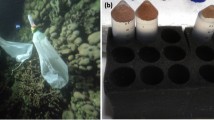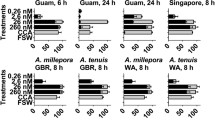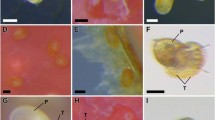Abstract
Surfaces from the habitat of adult Haliotis rubra were tested as inducers of larval settlement to determine the cues that larvae may respond to in the field. Settlement was high on the green algal species Ulva australis and Ulva compressa (Chlorophyta), the articulated coralline algae Amphiroa anceps and Corallina officinalis, and encrusting coralline algae (Rhodophyta). Biofilmed abiotic surfaces such as rocks, sand and shells did not induce settlement. Ulvella lens was also included as a control. Treatment of U. australis, A. anceps and C. officinalis with antibiotics to reduce bacterial films on the surface did not reduce the settlement response of H. rubra larvae. Similarly, treatment of these species and encrusting coralline algae with germanium dioxide to reduce diatom growth did not significantly reduce larval settlement. These results suggest that macroalgae, particularly green algal species, may play an important role in the recruitment of H. rubra larvae in the field and can be used to induce larval settlement in hatchery culture.








Similar content being viewed by others
References
Andrew NL, Underwood AJ (1992) Associations and abundance of sea urchins and abalone on shallow subtidal reefs in southern New South Wales. Aust J Mar Freshw Res 43:1547–1559
Andrew NL, Worthington DG, Brett PA, Bentley NR, Chick C, Blount C (1998) Interactions between the abalone fishery and sea urchins in New South Wales. NSW Fish Fin Rep Ser 12:1–91
Barlow LA (1990) Electrophysiological and behavioral responses of larvae of the red abalone (Haliotis rufescens) to settlement-inducing substances. Bull Mar Sci 46:537–554
Baxter G, Morse DE (1987) G protein and diacylglycerol regulate metamorphosis of planktonic molluscan larvae. Proc Natl Acad Sci USA 84:1867–1970
Boarder SJ, Shpigel M (2001) Comparative performances of juvenile Haliotis roei fed on enriched Ulva rigida and various artificial diets. J Shell Res 20:653–657
Bryan PJ, Qian PY (1998) Induction of larval attachment and metamorphosis in the abalone Haliotis diversicolor (Reeve). J Exp Mar Biol Ecol 223:39–51
Caley MJ, Carr ME, Hixon MA, Hughes TP, Jones GP, Menge BA (1996) Recruitment and the local dynamics of open marine populations. Ann Rev Ecol Sys 27:477–500
Daume S, Brand-Gardner S, Woelkerling WJ (1999a) Settlement of abalone larvae (Haliotis laevigata Donovan) in response to non-geniculate coralline red algae (Corallinales, Rhodophyta). J Exp Mar Biol Ecol 234:125–143
Daume S, Brand-Gardner S, Woelkerling WJ (1999b) Preferential settlement of abalone larvae: diatom films vs non-geniculate coralline red algae. Aquaculture 174:243–254
Daume S, Krsinich A, Farrell S, Gervis M (2000) Settlement, early growth and survival of Haliotis rubra in response to different algal species. J Appl Phycol 12:479–488
Daume S, Huchette S, Ryan S, Day RW (2004) Nursery culture of Haliotis rubra: the effect of cultured algae and larval density on settlement and juvenile production. Aquaculture 236:221–239
Gallardo WG, Buen SA (2003) Evaluation of mucus, Navicula, and mixed diatoms as larval settlement inducers for the tropical abalone Haliotis asinina. Aquaculture 221:357–364
Hadfield MG, Paul VJ (2001) Natural chemical cues for settlement and metamorphosis of marine-invertebrate larvae. In: McClintock JB, Baker JB (eds) Marine chemical ecology. CRC Press, Boca Raton, pp 431–461
Hahn KO (1989) Handbook of culture of abalone and other marine gastropods. CRC Press, Boca Raton Florida
Holmström C, Kjelleberg S (2000) Bacterial interactions with marine fouling organisms. In: Evans LV (ed) Biofilms: recent advances in their study and control. Harwood academic publishers, Australia, pp 101–116
Janke K (1990) Biological interactions and their role in community structure in the rocky intertidal of Helgoland German Bight North Sea. Helgol Meeresunters 44:219–264
Johnson CR, Sutton DC (1994) Bacteria on the surface of crustose coralline algae induce metamorphosis of the crown-of-thorns starfish Acanthaster planci. Mar Biol 120:305–310
Johnson LG, Babcock RC (1994) Temperature and the larval ecology of the crown-of-thorns starfish, Acanthaster planci. Biol Bull 187:304–308
Krug PJ, Manzi AE (1999) Waterborne and surface-associated carbohydrates as settlement cues for larvae of the specialist marine herbivore Alderia modesta. Biol Bull 197:94–103
Leitz T (1997) Induction and metamorphosis of Cnidarian larvae: signals and signal transduction. Inv Rep Dev 31:109–122
Mansilla A, Werlinger C, Nelso N (2002) Effect of photoperiod and light intensity on the development of tetraspores and carpospores of Mazzaella laminarioodes (Bory) Fredericq (Gigartinales–Rhodophyta). Anal Ins Pat Ser Cien Nat 30:49–60
Morse ANC, Froyd CA, Morse DE (1984) Molecules from cyanobacteria and red algae that induce settlement and metamorphosis in the mollusc Haliotis rufescens. Mar Biol 81:293–298
Moss GA (1999). Factors affecting settlement and early post-settlement survival of the New Zealand abalone Haliotis australis. N Z J Mar Freshwat Res 33:271–278
Negri AP, Webster NS, Hill RT, Heyward AJ (2001) Metamorphosis of broadcast spawning corals in response to bacteria isolated from crustose algae. Mar Ecol Prog Ser 223:121–131
Neori A, Shpigel M, Ben-Ezra D (2000) A sustainable integrated system for culture of fish, seaweed and abalone. Aquaculture 186:279–291
Prescott LM, Harley JP, Klein DA (1995) Microbiology. Wm C. Brown Publishers, Dubuque
Roberts R (2001) A review of settlement cues for larval abalone (Haliotis spp.). J Shell Res 20:571–586
Roberts RD, Nicholson CM (1997) Variable response from abalone larvae (Haliotis iris, H. virginea) to a range of settlement cues. Moll Res 18:131–141
Rodriguez SR, Ojeda FR, Inestrosa NC (1993) Settlement of benthic marine invertebrates. Mar Ecol Prog Ser 97:193–207
Seki T, Taniguchi K, Karuta K (1997) The metamorphosis inducing role of dibromomethane on the japanese abalone Haliotis discus hannai Ino, 60 pp. In: Abstracts of the 3rd International Abalone Symposium: Biology, Fisheries and Culture. Montery, CA, USA
Sousa WP (1979) Disturbance in marine intertidal boulder fields: the nonequilibrium maintenance of species diversity. Ecology 60:1225–1239
Steinberg PD, de Nys R, Kjelleberg S (2001) Chemical mediation of surface colonization. In: McClintock JB, Baker BJ (eds) Marine chemical ecology. CRC Press, Boca Raton, pp 355–387
Swanson RL, Williamson JE, de Nys R, Kumar N, Bucknall MP, Steinberg PD (2004) Induction of settlement of larvae of the sea urchin Holopnuestes purpurascens by histamine from a host alga. Biol Bull 206:161–172
Takami H, Kawamura T, Yamashita Y (1997) Survival and growth rates of post-larval abalone Haliotis discus hannai fed conspecific trail mucus and/or benthic diatom Cocconeis scutellum var. parva. Aquaculture 152:129–138
Toonen RJ, Pawlik JR (1994) Foundations of gregariousness. Nature 370:511–512
Underwood AJ, Jernakoff P (1981) Effects of interactions between algae and grazing gastropods on the structure if a low shore inter tidal algal community. Oecologia 48:221–233
Williamson JE, de Nys R, Kumar N, Carson DG, Steinberg PD (2000) Induction of metamorphosis in the sea urchin Holopneustes purpurascens by a metabolite complex from the algal host Delisea pulchra. Biol Bull 198:332–345
Wright JT, Steinberg PD (2001) Effect of variable recruitment and post-recruitment herbivory on local abundance of a marine alga. Ecology 82:2200–2215
Xue-wu L, Gordon ME (1987) Tissue and cell culture of New Zealand Pterocladia and Porphyra species. Hydrobiologia 151/152:147–154
Acknowledgements
This research was supported by an Australian Postgraduate Award to MJH, an ARC Large Grant to PDS and RdN, and the Centre for Marine Biofouling and Bio-Innovation. We thank Craig Brand and Nick Savva from NSW Fisheries Research Institute for both larval rearing and advice, and Rebecca Swanson for assistance in the laboratory. Three anonymous reviewers provided helpful comments to improve the manuscript.
Author information
Authors and Affiliations
Corresponding author
Additional information
Communicated by M. S. Johnson, Crawley
Rights and permissions
About this article
Cite this article
Huggett, M.J., de Nys, R., Williamson, J.E. et al. Settlement of larval blacklip abalone, Haliotis rubra, in response to green and red macroalgae. Marine Biology 147, 1155–1163 (2005). https://doi.org/10.1007/s00227-005-0005-6
Received:
Accepted:
Published:
Issue Date:
DOI: https://doi.org/10.1007/s00227-005-0005-6




